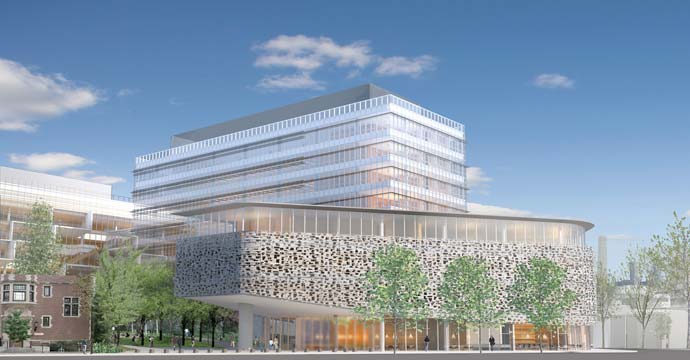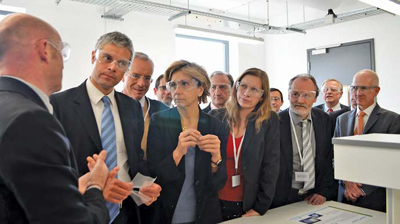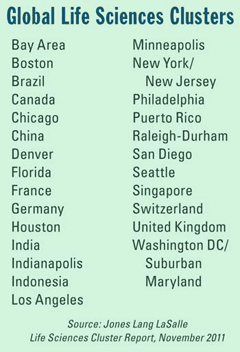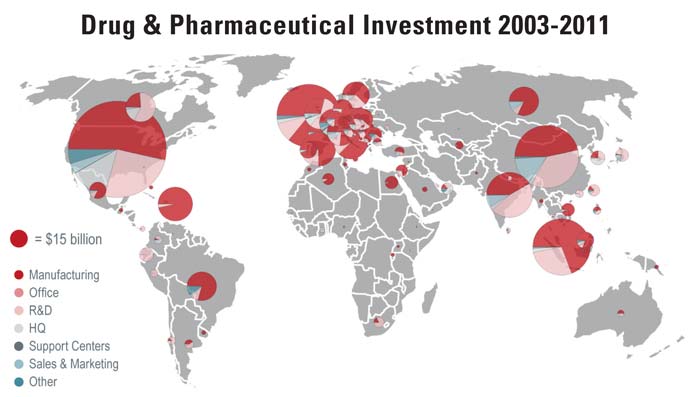In laboratories around the world, researchers are racing to find cures that will drive business. But meanwhile, their own world — the business of life sciences — is profoundly changing. Driven by the implications of patent loss, rising research and development costs and declining return on investment, downward pricing pressure and other factors, the industry is regrouping to increase productivity and business performance.
Life sciences cluster locations are experiencing the effects of these global trends in their own local ways. In Jones Lang LaSalle’s Global Life Sciences Cluster Report we explored clusters around the world, highlighting established life sciences regions, identifying emerging clusters and providing insights into the dynamics behind each. The list on p. 50 shows the top established and emerging clusters worldwide; more information on each can be found in the full report.
Site Selection wondered if we could dig deeper to deliver some on-the-ground observations. So here we present our insider’s view from four of these prominent life sciences clusters, chosen for their varying histories and current responses to industry pressures: the Boston area, Central and South Florida, Singapore and Bavaria, Germany. Boston and Bavaria are both long-established centers of excellence. Singapore, on the other hand, represents an emerging cluster that has through concerted and innovative effort relatively recently come into its own. And Florida is a state to watch, with a focused effort to develop the life sciences industry.
The divergent ways that these markets are evolving indicate that future industry success will not be defined by a single strategy. Instead, business strategists will need to approach each location differently, accounting for each region’s unique blend of human resources, academic infrastructure, business community dynamics and ability to invest, and finally, each community’s aspirations for their life sciences sector.
The Global Hub: Boston and
Cambridge, Massachusetts
Ground zero for global life sciences is considered by many to be Cambridge, Mass., with talent resident at Harvard, Massachusetts Institute of Technology and other area universities. But in reality, it’s more than just the Cambridge area that makes Boston a focus of innovation. A well-developed ecosystem encapsulates the urban streets and suburban freeways of the area, stretching far beyond Cambridge and into the suburban corridors featuring leading research hospitals and big name biopharmaceutical companies.
The diversity of the Boston area’s life sciences community is reflected in its labor force. Despite being known for its accomplished twenty-somethings working under seasoned leaders in their fields, Boston features more than 85,000 high-tech research employees and more than 340,000 hospital and medical employees. In fact, the area’s number of workers in biotech R&D is seven times the national average.
CEOs and others looking for funding could not be walking on more fertile ground. Massachusetts is home to five of the top eight NIH-funded hospitals in the United States, as well as the top five NIH-funded universities (Harvard, University of Massachusetts, Boston University, MIT, and Tufts). Not coincidentally, venture capital firms commonly look to Boston area start-ups for early investment in biotechnology, pharmaceuticals, medical devices, diagnostics and bioinformatics. To augment direct funding, the Commonwealth of Massachusetts provides significant tax incentives and other offerings to support the growth of the life sciences industry.

But these days if you follow the money, you might get lost bouncing between Cambridge and the Boston ‘burbs. One big shakeup in the region is the operational bifurcation of biotech behemoth Biogen. Originally a Cambridge company, Biogen moved to suburban Weston, Mass., along the Route 128 life sciences corridor a few years ago, joining other big-name firms and UMass Medical Center. Biogen is continuing to leverage its roots in pursuit of talent, building two new buildings in East Cambridge that will total more than 497,000 sq. ft. (46,171 sq. m.) of office and laboratory space. As is typical for the Boston area, rather than creating distress, the space that Biogen is leaving along Route 128 in favor of Cambridge is expected to create opportunity for smaller firms and start-ups to co-locate with the many prominent pharmaceutical and biotechnology companies in the area.

Conversely, in 2011 Vertex Pharmaceuticals announced that it will relocate from Cambridge into 1.1 million sq. ft. (102,190 sq. m.) of office and lab space at the Fan Pier development in north Boston, representing the largest private development project in the city’s history. (See the May 2011 issue of Site Selection for detailed reporting on this project.)
As the life sciences industry continues to permeate the entire metropolitan area, the Massachusetts Biotechnology Council has even developed a rating system, dubbing northwest suburban Lexington and Bedford, among others, as “Platinum BioReady Communities.”
As new buildings and spaces emerge throughout the region, the most interesting activity might be happening within the life sciences workplaces themselves. Walking the halls of start-ups and Big Pharma alike, traditions are being challenged at every turn. As the culture of drug discovery development continues to evolve, so does the need to design laboratory and office space to reflect and support collaboration and access to information.
The East Coast Upstart:
Central and South Florida
Unlike Boston, Florida does not have a history in the life sciences industry that goes back to the Founding Fathers. Rather, the state offers a rare combination of a large aging population available for clinical trial work, combined with a commitment to business-friendly economic development. Together with other factors, these trends mean that Florida is expected to add more than 6,000 life sciences jobs in the coming years.
The role of BioFlorida, the state’s bioscience industry association, cannot be underestimated. Representing companies and research centers to help promote innovation, foster collaboration and create a business-friendly ecosystem for life sciences companies, the organization has been able to drive grant funding for high-tech businesses and industry tax exemptions, quick-response training grants and Enterprise Zone sales tax credits.

All that said, as you walk down Miami Beach, it’s easy to slip back into thinking of Florida as more of a tourist than a business destination. But that dynamic is changing, thanks to a few committed companies, big local names and several new research parks developed under a “build it and they will come” model.
At the top of that list is Israel-based generics giant Teva Pharmaceuticals. In 2006, Teva committed itself to the area with its US$7.6-billion purchase of Ivax, and in 2010 it named Ivax founder and Miami local Dr. Phillip Frost as the company’s chairman.
Beyond the beachfront, the University of Miami Life Science & Technology Park (UMLSTP) master plan includes up to five buildings expected to ultimately total up to 2 million sq. ft. (185,800 sq. m.) of retail, lab and office space. Highlights include several medical device firms, multiple clinical research areas, a presence from biomedical technology companies and the Community Blood Centers of South Florida lab facility. The park will include a hotel and conference facility in addition to the research, office, clinical and retail space.
These new centers of excellence did not emerge in a vacuum. Public sector investment in the Scripps Research Institute, and particularly its Neurosciences Group and high-through-put screening center, and the nearby Max Planck Institute for Bioimaging, both in the Jupiter area near Palm Beach, helped serve as a catalyst for the life sciences industry throughout South Florida.
Continuing up the road north, Central Florida is not only home to several new life sciences-focused developments, but it has also played a major role in recent high-profile site selection competitions. For example, Orlando-based generic drug company Nephron Pharmaceuticals maintains a significant presence in Orlando, and included the city on a recent short list for a new operation that would have created more than 100 professional jobs. While Florida didn’t win that time around (the project went to South Carolina — see the March 2012 issue of Site Selection), it continues to focus its attraction efforts on new biopharma R&D, clinical trial and manufacturing facilities, and it has had other recent successes.

High on the local development radar is the 7,000-acre (650-hectare) Lake Nona Medical City under construction by the Tavistock Group, which will include the University of Central Florida College of Medicine, the Sanford-Burnham Medical Research Institute at Lake Nona, the Orlando VA Medical Center and the University of Florida Research and Academic Center. Not coincidental to its large number of retirees, this concentration of medical centers provides life sciences companies with a continually growing number of hospitals and research institutions with whom there are partnership opportunities.
If virtual spaces can claim a “real world” place, Florida is becoming known for it, as the state’s many newly constructed medical and life sciences facilities are home to multiple cutting-edge virtual training and simulation centers such as the 35,000-sq.-ft. (3,252-sq.-m.) training facility for a new medical simulation system called the Simulated Learning Enhancement and Advance Research Network at Lake Nona. Similarly, the University of South Florida’s Center for Advanced Medical Learning and Simulation (CAMLS) in the Tampa Central Business District will be a state-of-the-art, 90,000-sq.-ft. (8,361-sq.-m.) medical conference facility. CAMLS will feature a training center for USF Health’s Graduate Biomedical Degree program, an auditorium, a 6,000-sq.-ft. (557-sq.-m.) lab, and a 10,000-sq.-ft. (930-sq.-m.) Virtual Hospital.
Both academic specializations and incubator programs bolster the Central and South Florida life sciences cluster. A walk through the University of Florida’s Sid Martin Biotechnology Incubator shows the diversity of the research going on, including wet labs, small and large animal research facilities, common equipment labs, fermenters, greenhouses and other new facilities and utilities.

Research & They Will Come:
Republic of Singapore
Singapore has made headlines by hiring prominent scientists, who in turn attract others to work with them. This city-state’s stable political structures, strong intellectual property protection, and favorable regulatory and tax policies make Singapore an attractive business location in general — its development and support for several biotechnology business parks makes Singapore one of the fastest-emerging and exciting life sciences clusters in the world.
When you speak with Western biotech executives in Singapore, you’ll notice that they are comfortable on this country-island, and for good reason: They are using it as their launching pad for all of Asia.
With its business-friendly policies, developed by the Singapore Economic Development Board (EDB), Singapore has become a common base for regional headquarters of companies marketing to high-growth Asian consumer markets such as India and China, on top of its role as a hub for investigation of both global and regional diseases. But it’s not just about sales and research: Contract manufacturing and re-exportation of biopharmaceuticals are big business on the island. Singapore is home to manufacturing facilities of eight of the top 10 biopharmaceutical companies and all of the top 10 medical device manufacturers.
Life sciences research activity in Singapore largely occurs in government-supported biotechnology centers. The area’s largest research park — Biopolis, developed by Singapore’s largest life sciences developer, JTC Corp. — gave Singapore its nickname as the “Biopolis of Asia.” The park features more than 3 million sq. ft. (278,700 sq. m.) of space, including an integrated biomedical research complex, office buildings, laboratories and facilities that provide clinical trial support.
Across town in Singapore’s Western region, JTC developed the Tuas Biomedical Park (TBP), a 916-acre (371-hectare) biomedical manufacturing cluster that complements Biopolis. TBP offers shovel-ready sites for manufacturing for Big Pharma and contract manufacturing companies alike.
Singapore is a classic example of how strong public sector support for both academia and private enterprise can drive the success of an emerging cluster. A feeling of a rising tide permeates this small country, with more than 16,000 people employed in the industry, including many young researchers and business people contributing an energy that signals strong future opportunity for both Singaporeans and the Western business people rapidly increasing in numbers.
In October 2010, the government announced it would earmark S$3.7 billion (approx. US$3 billion) for biomedical R&D over the next five years as part of its larger Research Innovation and Enterprise 2015 fund.
The Original Home of Vertical
Integration: Bavaria, Germany
Long before Singapore put its stake in the ground, there was Bavaria. This area has a little bit of everything — something emerging cluster cities should note. While the life sciences industry enjoys several clusters across Germany, Bavaria in particular has been able to expand its activity throughout the value chain, including robust activity in R&D, sales and manufacturing — unusual in a world where locations tend to specialize in either the “sexy” R&D activities, or manufacturing locations that require a lower-cost work force.
The Bavaria Biotech Cluster is made up of more than 200 companies, employing some 16,000 people; half of Germany’s newly formed companies in 2010 were located in the Munich area within Bavaria. In addition to global companies, Germany supports a large number of smaller life sciences companies, many of them with a presence in the Bavaria Biotech Cluster.
For those looking for a model for innovation, look to the emerging start-up culture in Germany, where about 92 percent of pharmaceutical manufacturing companies employ fewer than 500 people. Bavaria also benefits from the classic German work ethic and management style: A productivity rate 10 percent above the average of Europe’s 15 core economies makes Germany one of the more attractive business locations in Europe.
While Bavaria brings it all together, it doesn’t do it without a broad base of life sciences industry concentration throughout Germany. Even during the economic crisis, the life sciences industry in Germany showed resilience. In 2009, the pharmaceutical sector grew by five percent, while the broader manufacturing industry saw a decline by 18 percent.
The life sciences industry is considered the leading sector for innovation in Germany. Approximately €1.2 billion (US$1.7 billion) was given in grants from 2006–2009 for innovations in biotechnology, pharmaceuticals and medical technology as part of the federal government’s “High Tech Strategy”, and federal grants of more than €5.5 billion ($7.8 billion) are projected to be dedicated to the health care sector’s research during the period ending in 2016. Only the United States exceeds this volume of support.
The industry also benefits from a number of renowned universities and research institutes, including the Max Planck Society and the Leibniz Association. The National Research Strategy BioEconomy 2030 and the Health Research Framework Programme, both of which were implemented by the German federal government in 2010, provide further political support for the industry. Funding of about €8 billion ($11.3 billion) is available for allocation over the next years as part of this program.
Location Transformation Worldwide
From the Biopolis of Asia to the hallowed halls of Cambridge, the shape of the laboratories, offices and manufacturing facilities in the life sciences industry is profoundly changing. Once, an executive might have flown first-class across an ocean for a meeting — but now she may connect to a virtual lab in Florida via teleconference to meet about progress on a new drug.
Where once a sales force might have been concentrated in North America, a multinational team based in Singapore could now easily become a corporation’s top producers.
From new location choices to the new collaborative workspaces within them, the industry is transforming its built environment to prepare for the leaner and more efficient decades to come.
Matt Jackson (matt.jackson@am.jll.com), Matt Highfield and Shannon Curley are part of the leadership team in the Business Consulting Group at Jones Lang LaSalle. They help companies tackle global location footprint challenges in Life Sciences and other industries and have worked in more than 40 countries.
